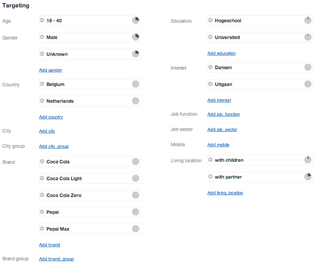
Advertising is the practice and techniques employed to bring attention to a product or service. Advertising aims to put a product or service in the spotlight in hopes of drawing it attention from consumers. It is typically used to promote a specific good or service, but there are wide range of uses, the most common being the commercial advertisement.

A data set is a collection of data. In the case of tabular data, a data set corresponds to one or more database tables, where every column of a table represents a particular variable, and each row corresponds to a given record of the data set in question. The data set lists values for each of the variables, such as for example height and weight of an object, for each member of the data set. Data sets can also consist of a collection of documents or files.

Graphic design is a profession, academic discipline and applied art whose activity consists in projecting visual communications intended to transmit specific messages to social groups, with specific objectives. Graphic design is an interdisciplinary branch of design and of the fine arts. Its practice involves creativity, innovation and lateral thinking using manual or digital tools, where it is usual to use text and graphics to communicate visually.

Sir Ronald Aylmer Fisher was a British polymath who was active as a mathematician, statistician, biologist, geneticist, and academic. For his work in statistics, he has been described as "a genius who almost single-handedly created the foundations for modern statistical science" and "the single most important figure in 20th century statistics". In genetics, his work used mathematics to combine Mendelian genetics and natural selection; this contributed to the revival of Darwinism in the early 20th-century revision of the theory of evolution known as the modern synthesis, being the one to most comprehensively combine the ideas of Gregor Mendel and Charles Darwin. For his contributions to biology, Richard Dawkins proclaimed Fisher as "the greatest of Darwin's successors". He is considered one of the founding fathers of Neo-Darwinism.
Marketing research is the systematic gathering, recording, and analysis of qualitative and quantitative data about issues relating to marketing products and services. The goal is to identify and assess how changing elements of the marketing mix impacts customer behavior.
In marketing, market segmentation is the process of dividing a broad consumer or business market, normally consisting of existing and potential customers, into sub-groups of consumers based on shared characteristics.
Personalized marketing, also known as one-to-one marketing or individual marketing, is a marketing strategy by which companies leverage data analysis and digital technology to deliver individualized messages and product offerings to current or prospective customers. Advancements in data collection methods, analytics, digital electronics, and digital economics, have enabled marketers to deploy more effective real-time and prolonged customer experience personalization tactics.
A data broker is an individual or company that specializes in collecting personal data or data about companies, mostly from public records but sometimes sourced privately, and selling or licensing such information to third parties for a variety of uses. Sources, usually Internet-based since the 1990s, may include census and electoral roll records, social networking sites, court reports and purchase histories. The information from data brokers may be used in background checks used by employers and housing.

Lewis Madison Terman was an American psychologist, academic, and proponent of eugenics. He was noted as a pioneer in educational psychology in the early 20th century at the Stanford School of Education. Terman is best known for his revision of the Stanford–Binet Intelligence Scales and for initiating the longitudinal study of children with high IQs called the Genetic Studies of Genius. As a prominent eugenicist, he was a member of the Human Betterment Foundation, the American Eugenics Society, and the Eugenics Research Association. He also served as president of the American Psychological Association. A Review of General Psychology survey, published in 2002, ranked Terman as the 72nd most cited psychologist of the 20th century, in a tie with G. Stanley Hall.
These are the references for further information regarding the history of the Republican Party in the U.S. since 1854.
Ethel Mary Elderton (1878–1954) was a British biometrician, statistician and eugenics researcher who worked with Francis Galton and Karl Pearson.
Artificial intelligence marketing (AIM) is a form of marketing that uses artificial intelligence concepts and models such as machine learning, Natural process Languages, and Bayesian Networks to achieve marketing goals. The main difference between AIM and traditional forms of marketing resides in the reasoning, which is performed by a computer algorithm rather than a human.

Targeted advertising is a form of advertising, including online advertising, that is directed towards an audience with certain traits, based on the product or person the advertiser is promoting.
Social network advertising, also known as social media targeting, is a group of terms used to describe forms of online advertising and digital marketing that focus on social networking services. A significant aspect of this type of advertising is that advertisers can take advantage of users' demographic information, psychographics, and other data points to target their ads.

Social media marketing is the use of social media platforms and websites to promote a product or service. Although the terms e-marketing and digital marketing are still dominant in academia, social media marketing is becoming more popular for both practitioners and researchers.

Web browsing history refers to the list of web pages a user has visited, as well as associated metadata such as page title and time of visit. It is usually stored locally by web browsers in order to provide the user with a history list to go back to previously visited pages. It can reflect the user's interests, needs, and browsing habits.
Social media intelligence comprises the collective tools and solutions that allow organizations to analyze conversations, respond to synchronize social signals, and synthesize social data points into meaningful trends and analysis, based on the user's needs. Social media intelligence allows one to utilize intelligence gathering from social media sites, using both intrusive or non-intrusive means, from open and closed social networks. This type of intelligence gathering is one element of OSINT.
Chris Wiggins is an associate professor of applied mathematics at Columbia University. In 2010 he co-founded hackNY, a nonprofit organization focused on connecting students with startups in New York City. Since 2014, he has been the Chief Data Scientist at The New York Times.
Predatory advertising, or predatory marketing, can be largely understood as the practice of manipulating vulnerable persons or populations into unfavorable market transactions through the undisclosed exploitation of these vulnerabilities. The vulnerabilities of persons/populations can be hard to determine, especially as they are contextually dependent and may not exist across all circumstances. Commonly exploited vulnerabilities include physical, emotional, social, cognitive, and financial characteristics. Predatory marketing campaigns may also rely on false or misleading messaging to coerce individuals into asymmetrical transactions. The history of the practice has existed as long as general advertising, but particularly egregious forms have accompanied the explosive rise of information technology. Massive data analytics industries have allowed marketers to access previously sparse and inaccessible personal information, leveraging and optimizing it through the use of savvy algorithms. Some common examples today include for-profit college industries, "fringe" financial institutions, political micro-targeting, and elder/child exploitation. Many legal actions have been taken at different levels of government to mitigate the practice, with various levels of success.

Spotify Wrapped is a viral marketing campaign by Spotify. Released annually since 2016, every early December, the campaign allows Spotify users to view a compilation of data about their activity on the platform over the past year and invites them to share it on social media.








